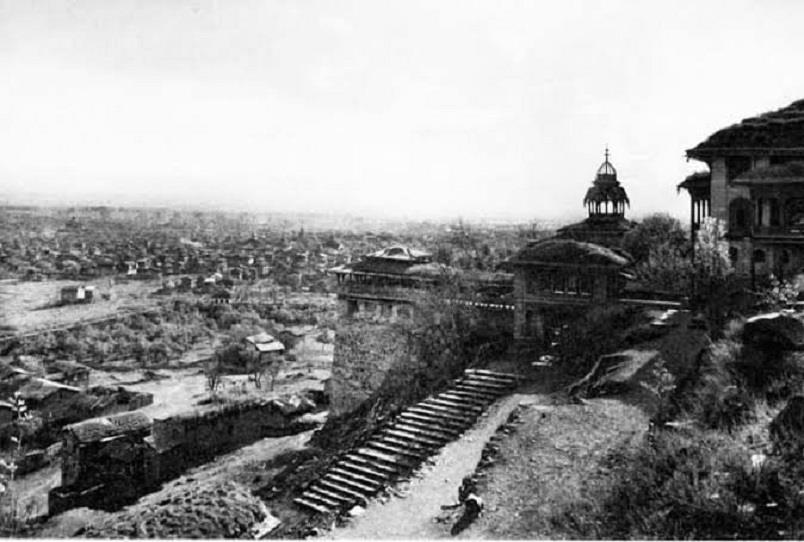
Tracing 'Kashmir'
Tracing 'Kashmir'
By Moin S. Hakak
Who made Kashmir habitable: sage Kashyapa, monk Madhyantika, or prophet Solomon? An analysis of the Sanskrit, Chinese and Persian mythologies reveals mutualities in the content and disparity in the characters related to the origins of Kashmir. Kasyapa is evoked by the Sanskrit and Persian mythologies, Madhyantika by the Chinese mythologies and prophet Solomon by the Persian mythologies. Despite the changing protagonists, the emergence of the land of Kashmir from the waters remains a consistent theme across these mythologies–mostly being credited to the celestial beings.
ADVERTISEMENTThe Sanskrit mythologies are derived primarily from the 6th – 8th century text
Nilamatapurana (which also informs the mythology of Rajatarangini). According to Nilamatapurana, Kashmir was a vast lake called Satidesa. This lake was inhabited by a demon called Jalodbhava. The other dwellers of the lake–the Nagas–did not get along well with Jalodbhava. Nila, the lord of the Nagas, approached Kasyapa, a wandering sage, for respite from the demon's horrors. Kasyapa took the case to Brahma, who, along with forty-three gods and goddesses (and their families), descended on Kashmir to fight the water demon. Jalodbhava, seeing the entourage of the gods, took refuge within the depths of the waters. Realising that Jalodbhava cannot be defeated within the waters, Vishnu ordered Ananda to strike his plough on the mountains and drain the lake's water. Once Jalodbhava was exposed, Vishnu slayed him with his Sudarshan chakra.
Now that the land had emerged from the lake, Kasyapa requested that Brahma let humans settle in the valley. Nila (the lord of the Nagas) protested against this request of Kasyapa, refusing to share Kashmir with the humans. Nila's protest was met with Kasyapa's resentment. An offended Kasyapa, as a punishment, ordered Nila to share Kashmir with the humans for six months and with the flesh-eating monsters–the Pisachas–for the rest of the year. Thus, the land of Kashmir was made habitable for human settlement, for a bi-annual period, according to Sanskrit mythology.
Chinese myths attribute the inhabitation of Kashmir to Madhyantika (Mo-t'ien-ti-ka). As stated by Xuanzang, Kashmir used to be a vast lake. In this lake lived a dragon. A disciple of Ananda (a friend of Buddha), Madhyantika, came to Kashmir to propagate Buddhism. On reaching the lake, Madhyantika requested the dragon to grant him space to meditate. As the dragon granted the wish, Madhyantika grew larger and larger, draining the lake and forcing the dragon to leave.
Once land emerged from the waters, Madhyantika built five hundred sangrahamas in Kashmir. To tend to the needs of the monks of these sangrahamas, Madhyantika brought and bought people from the surrounding regions. The people eventually rebelled against the monks and constituted the first population of Kashmir.
The Persian origin myths of Kashmir associate three persons–Kashf, Kashyap and the prophet Solomon with making Kashmir habitable. According to Haider Malik Chadoora, God ordered Prophet Solomon to visit Kashmir. Pleased by the climate of Kashmir, Solomon tasked two jinns–Kashf and Mir–to desiccate Kashmir. Once the land of Kashmir was made habitable, the prophet Solomon invited people from neighbouring regions to settle in Kashmir. These new settlers took to agriculture. As the society grew complex, they felt the need for a king. Thus, the prophet Solomon installed a king in Kashmir.
As mentioned in Baharistan-e-shahi, it was a hermit named Kasyap who made a supplication to God requesting to make Kashmir habitable. Answering his prayers, God sent three angels to drain the waters of Kashmir. Once the water was drained, a person named Bekdarat sowed various seeds, thus starting the practice of agriculture in Kashmir.
As is evident from the above mythologies, while the protagonists of these mythologies are different, their content reveals consistency. This provokes the question of whether this consistency is accidental or deliberate. It also provokes a quest to understand the actual formations of Kashmir that can be scientifically verified.
On turning towards the geological formations of Kashmir, the story begins 50 million years ago when the Indian tectonic plate collided with the Asian plate. This collision gave rise to what we today know as the Himalayas. The continuous collisions almost 4 million years ago created a depression that was soon filled with water in the absence of an outlet. Thus came to existence a large in-land lake of Kashmir. However, geologically, the draining of this vast lake was the work of tectonic activities and the consequent attrition, not of an individual.
Other similar traits of these mythologies run in close proximity to scientifically verifiable truths. For example, the bi-annual migration of people from Kashmir (as mentioned in the Nilamatapurana) alludes to the frigid climate of Kashmir and the consequent migration of people, rather than migration enforced by the raw flesh-eating monsters–the Pisachas. Similarly, agriculture being succeeded by a class-based society (as mentioned in the myth of Solomon) also finds reverberation in the civilisations of Mesopotamia, Egypt, the Indus Valley, China and Maya, among others.
Despite the variations in the characters involved in the origin mythologies of Kashmir, the geological content within them remains consistent. Whether this 'safeguarding' of the geological history by shrouding them within myths was deliberate or accidental is still a mystery. But what isn't a mystery anymore is that a massive chunk of these mythologies resonate with historical and geological truths, irrespective of whether it was sage Kasyapa, monk Madhyantika, or prophet Solomon who made Kashmir habitable.
Views expressed in the article are the author's own and do not necessarily represent the editorial stance of Kashmir Observer
- The author is Research Scholar, Department of History, CHRIST University, Bangalore.

Legal Disclaimer:
MENAFN provides the information “as is” without warranty of any kind. We do not accept any responsibility or liability for the accuracy, content, images, videos, licenses, completeness, legality, or reliability of the information contained in this article. If you have any complaints or copyright issues related to this article, kindly contact the provider above.






















Comments
No comment